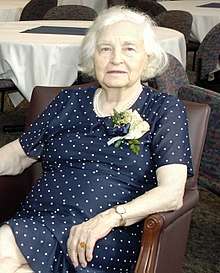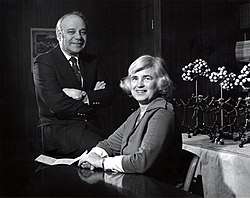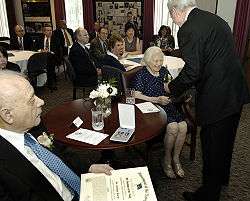Isabella Karle
Isabella Karle (December 2, 1921 – October 3, 2017) was an American chemist who was instrumental in developing techniques to extract plutonium chloride from a mixture containing plutonium oxide.[1] For her scientific work, Karle received the Garvan–Olin Medal, Gregori Aminoff Prize, Bower Award, National Medal of Science, and the Navy Distinguished Civilian Service Award (which is the Navy's highest form of recognition to civilian employees).
Isabella Karle | |
|---|---|
 Karle at her retirement in 2009 | |
| Born | Isabella Helen Lugoski December 2, 1921 |
| Died | October 3, 2017 (aged 95) |
| Nationality | United States |
| Alma mater | University of Michigan |
| Spouse(s) | Jerome Karle (m. 1942; 3 children) |
| Awards | Garvan–Olin Medal (1976) Gregori Aminoff Prize (1988) Bower Award (1993) National Medal of Science (1995) |
| Scientific career | |
| Fields | Crystallography |
| Doctoral advisor | Lawrence O. Brockway |
Early life


She was born as Isabella Helen Lugoski in Detroit, Michigan on December 2, 1921, the daughter of immigrants from Poland.[1] She attended the local public schools, while at school, a female chemistry teacher led her to her pursuit of the field as a career.[2] She attended the University of Michigan on full scholarship, where she majored in physical chemistry and received a Bachelor of Science at age 19, followed by Master of Science and Ph.D. degrees in the field. During her graduate work she met her future husband and scientific collaborator Jerome Karle; the two were both advised in their Ph.D. studies by Lawrence Brockway.[3][4]:89
Career
Karle worked on the Manhattan Project during World War II, where she developed techniques to extract plutonium chloride from a mixture containing plutonium oxide.[5]
She joined the United States Naval Research Laboratory (NRL) after the end of the war. At the NRL, her husband Jerome developed "direct methods" for analyzing structure of crystals. However, for many years the crystallographic community remained skeptical about their utility.[1][6] Isabella Karle was the first person to apply the method. She developed the symbolic addition procedure that connects the theoretical "direct method" apparatus and actual X-ray diffraction data.[6] These contributions advanced the field of X-ray crystallography by enabling determination of the structure of crystals. This technique has played a major role in the development of new pharmaceutical products and other synthesized materials.[5]
In 1985, Jerome Karle was awarded the Nobel Prize in Chemistry, together with mathematician Herbert A. Hauptman, for developing direct methods for analyzing X-ray diffraction data. Jerome Karle and many other members of the crystallography community strongly believed that Isabella Karle should have shared the prize.[6][1]
Karle received many honors. She was elected a Fellow of the National Academy of Sciences (1978) and the American Academy of Arts and Sciences (1993).[7] In addition, she received the National Medal of Science (1995), various awards, and eight honorary doctorates.[8]
On July 31, 2009, Karle and her husband retired from the Naval Research Laboratory, after a combined 127 years of service to the United States Government, with Karle joining the NRL in 1946, two years after her husband.[5] Retirement ceremonies for the Karles were attended by United States Secretary of the Navy Ray Mabus, who presented the couple with the Department of the Navy Distinguished Civilian Service Award, the Navy's highest form of recognition to civilian employees.[5]
Death
She died on October 3, 2017 at a hospice in Alexandria, Virginia.[1]
Personal life
Karle was married to Jerome Karle with whom she had three daughters, all of whom work in scientific fields:[9]
- Louise Karle (born 1946) is a theoretical chemist
- Jean Karle (1950) is an organic chemist
- Madeleine Karle (1955) is a museum specialist with expertise in the field of geology.
Awards
- Garvan–Olin Medal (1976)
- Rear Admiral William S. Parsons Award (1988)
- Gregori Aminoff Prize (1988)
- Bijvoet Medal of the Bijvoet Center for Biomolecular Research (1989) [10]
- Bower Award (1993)
- National Medal of Science (1995)
- Navy Distinguished Civilian Service Award (2009)
References
- "Isabella L. Karle, chemist who helped reveal structure of molecules, dies at 95". Washington Post.
- Staff. " profile", Journal of Chemical Education. Accessed September 22, 2009.
- "Jerome Karle - Biographical". Nobelprize.org. Retrieved 10 March 2017.
- Kelly, Cynthia C. (27 January 2005). Remembering the Manhattan Project: Perspectives on the Making of the Atomic Bomb and Its Legacy. World Scientific. ISBN 9789814481786.
- McKinney, Donna. "Jerome and Isabella Karle Retire from NRL Following Six Decades of Scientific Exploration" Archived 2011-09-27 at the Wayback Machine, United States Naval Research Laboratory press release dated July 21, 2009. Accessed September 22, 2009.
- "Isabella Karle dies at age 95 | Chemical & Engineering News". cen.acs.org. Retrieved 2018-12-19.
- "Book of Members, 1780–2010: Chapter K" (PDF). American Academy of Arts and Sciences. Retrieved July 29, 2014.
- "Isabella Karle, Renowned Crystallographer and Chemist, Dies at 95". News. 2017-10-24. Retrieved 2018-12-19.
- Jerome Karle: The Nobel Prize in Chemistry 1985, Nobel Prize. Accessed September 22, 2009.
- "Bijvoet Medal". Bijvoet Center for Biomolecular Research. Archived from the original on 2017-09-12. Retrieved 2017-09-12.
Further reading
- Wayne, Tiffany K (2011). American women of science since 1900. ABC-CLIO. ISBN 9781598841596. OCLC 702118874.
- Shearer, Benjamin F; Shearer, Barbara Smith (1997). Notable women in the physical sciences a biographical dictionary. Greenwood Press. ISBN 0313293031.</ref>
External links
- 2015 Video interview with Isabella Karle by the Atomic Heritage Foundation Voices of the Manhattan Project
- 2005 Video Interview with Isabella Karle by the Atomic Heritage Foundation Voices of the Manhattan Project
- Massa, Antonia (2013). "Isabella Karle's Curious Crystal Method". Narratively: Human stories, boldly told. Retrieved 2013-12-05.